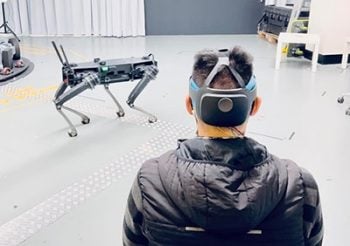It seems like one thing from science fiction: Don a specialised, digital headband and management a robotic utilizing your thoughts. However now, current analysis revealed in ACS Utilized Nano Supplies has taken a step towards making this a actuality. By designing a particular, 3D-patterned construction that doesn’t depend on sticky conductive gels, the crew has created “dry” sensors that may measure the mind’s electrical exercise, even amidst hair and the bumps and curves the pinnacle.
A brand new sensor design built-in right into a blue headband was used to manage a robotic utilizing solely mind waves wirelessly.
Tailored from ACS Utilized Nano Supplies, 2023, DOI: 10.1021/acsanm.2c05546
Physicians monitor electrical indicators from the mind with electroencephalography (EEG), by which specialised electrodes are both implanted into or positioned on the floor of the pinnacle. EEG helps diagnose neurological issues however may also be included into “brain-machine interfaces,” which use mind waves to manage an exterior system, akin to a prosthetic limb, robotic or perhaps a online game. Most non-invasive variations contain “moist” sensors caught onto the pinnacle with a gloopy gel that may irritate the scalp and generally set off allergic reactions. As a substitute, researchers have been growing “dry” sensors that don’t require gels, however to date none have labored in addition to the gold-standard moist selection. Though nanomaterials like graphene might be an acceptable possibility, their flat and sometimes flaky nature make them incompatible with the uneven curves of the human head, significantly over lengthy durations. So, Francesca Iacopi and colleagues wished to create a 3D, graphene-based sensor primarily based on polycrystalline graphene that would precisely monitor mind exercise with none stickiness.
The crew created a number of 3D graphene-coated constructions with totally different shapes and patterns, every round 10 µm thick. Of the shapes examined, a hexagonal sample labored the most effective on the curvy, bushy floor of the occipital area — the spot on the base of the pinnacle the place the mind’s visible cortex is situated. The crew included eight of those sensors into an elastic headband, which held them in opposition to the again of the pinnacle. When mixed with an augmented actuality headset displaying visible cues, the electrodes may detect which cue was being considered, then work with a pc to interpret the indicators into instructions that managed the movement of a four-legged robotic — utterly hands-free. Although the brand new electrodes didn’t but work fairly in addition to the moist sensors, the researchers say that this work represents a primary step towards growing strong, simply carried out dry sensors to assist increase the functions of brain-machine interfaces.
Supply: acs.org



Discussion about this post